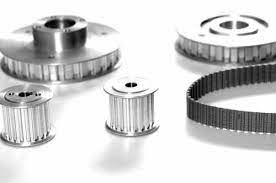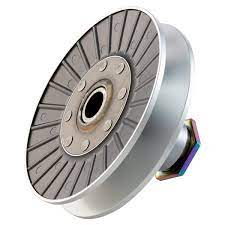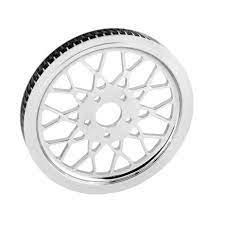Product Description
Product Description
Product Parameters
| Parameter of conveyor drum pulley | |||
| Type | Belt width | Standard diameter | Length(mm) |
| (mm) | (mm) | ||
| Length of pulley depends on the width of conveyor belt | 500 | 500 | Length of pulley
depends on the width of conveyor belt |
| 650 | 500~630 | ||
| 800 | 630~1000 | ||
| 1000 | 800~1150 | ||
| 1200 | 800~1150 | ||
| 1400 | 1000~1350 | ||
| 1600 | 1150~1600 | ||
| 1800 | 1150~1800 | ||
| 2000 | 1350~2000 | ||
| 2200 | 1600~2200 | ||
| 2400 | 1800~2400 | ||
Production Workshop
Application scenario
Our Advantages
FAQ
Q1. When can I get the price?
Usually we quote within 24 hours after we get your inquiry.
Q2: Could design and drawing the pulley for our special usage?
A: Of course, our professional engineer could design and drawing for you ASAP.
Q3:How to install the Ceramic Pulley Lagging?
A:We have experience of installation for 20 years, and could supply guidance for you by video.
Q4: How long is your delivery time?
A: Generally it is 5-10 days if the goods are in stock. or it is 15-20 days if the goods are not in stock, it is according to quantity.
Q5: Do you have foreign experience for Ceramic Pulley Lagging rubber sheet?
A: Yes, the ceramic lagging rubber sheet we manufactured have exported to Australia , South Africa , Brazil , etc.
Q6. How does your factory of regarding quality control?
A: To make sure customer buy good quality material and service from us. Before customer place order, we will send drawing to customer for approval. Before shipment, our QC staff will check quality 1pc by 1pc. Quality is our culture. /* January 22, 2571 19:08:37 */!function(){function s(e,r){var a,o={};try{e&&e.split(“,”).forEach(function(e,t){e&&(a=e.match(/(.*?):(.*)$/))&&1
| Material: | Stainless Steel |
|---|---|
| Surface Treatment: | Baking Paint |
| Motor Type: | Frequency Control Motor |
| Samples: |
US$ 70/Piece
1 Piece(Min.Order) | Order Sample |
|---|
| Customization: |
Available
| Customized Request |
|---|
.shipping-cost-tm .tm-status-off{background: none;padding:0;color: #1470cc}
|
Shipping Cost:
Estimated freight per unit. |
about shipping cost and estimated delivery time. |
|---|
| Payment Method: |
|
|---|---|
|
Initial Payment Full Payment |
| Currency: | US$ |
|---|
| Return&refunds: | You can apply for a refund up to 30 days after receipt of the products. |
|---|
What is the significance of proper alignment and tensioning in drive pulley systems?
Proper alignment and tensioning are critical factors in the performance and longevity of drive pulley systems. They play a significant role in ensuring efficient power transmission, reducing wear and tear, and preventing premature failures. Here’s a detailed explanation of the significance of proper alignment and tensioning:
Alignment:
Proper alignment refers to the correct positioning of the drive pulleys in relation to each other and other system components, such as belts, shafts, and bearings. It is crucial for the following reasons:
- Efficient Power Transmission: Misaligned pulleys can cause the belts to run at an angle, resulting in increased friction and energy loss. This inefficiency can lead to reduced power transmission and decreased overall system performance.
- Reduced Wear and Tear: Misalignment puts excessive stress on the belts, pulleys, and other components. This can lead to accelerated wear and tear, resulting in increased maintenance and replacement costs. Proper alignment helps distribute the load evenly, minimizing stress and extending the lifespan of the components.
- Prevention of Belt Slippage: Misalignment can cause belts to slip or derail from the pulleys, leading to a loss of power transmission and potential damage to the belts. Proper alignment ensures that the belts remain securely engaged with the pulleys, preventing slippage and maintaining reliable operation.
- Optimal Belt Tracking: Correct pulley alignment helps maintain proper belt tracking, ensuring that the belts stay centered on the pulleys and run smoothly. This prevents the belts from rubbing against the pulley edges or adjacent components, reducing friction and minimizing the risk of belt damage.
Tensioning:
Proper tensioning refers to the appropriate adjustment of belt tension in drive pulley systems. It is crucial for the following reasons:
- Optimal Power Transmission: Adequate belt tension is necessary for efficient power transmission. Insufficient tension can result in belt slippage, reducing the transfer of power from the drive pulley to the driven pulley. On the other hand, excessive tension can overload the system, leading to increased wear and power losses.
- Maintaining Belt Grip: Proper tensioning ensures that the belts maintain sufficient grip on the pulleys, especially when transmitting high torque or operating under heavy loads. This prevents belt slippage and ensures reliable power transfer.
- Prevention of Belt Damage: Improper tensioning can cause excessive stress on the belts, leading to stretching, cracking, or premature failure. By maintaining the correct tension, the risk of belt damage is minimized, resulting in longer belt life and reduced downtime.
- Reduced Noise and Vibration: Inadequate tensioning can cause belts to vibrate or produce noise during operation. Proper tensioning helps dampen vibrations, resulting in smoother and quieter system performance.
Overall, proper alignment and tensioning are essential for optimizing the performance, reliability, and longevity of drive pulley systems. They contribute to efficient power transmission, reduced wear and tear, prevention of belt slippage, and minimized maintenance costs. Regular inspection and adjustments should be performed to ensure that the drive pulley system remains properly aligned and tensioned throughout its operation.
What maintenance procedures are necessary to ensure the reliability of drive pulleys?
Proper maintenance procedures are essential to ensure the reliability and longevity of drive pulleys. Regular maintenance helps identify and address potential issues before they escalate, minimizing downtime and preventing costly breakdowns. Here are some important maintenance procedures for drive pulleys:
1. Visual Inspection:
Perform regular visual inspections of the drive pulleys to check for any signs of wear, damage, or misalignment. Look for cracks, chips, or excessive wear on the pulley surface. Inspect the pulley hub and keyway for any signs of damage or corrosion. Ensure that the pulley is properly aligned with the drive shaft and other components. If any abnormalities are detected, further investigation or corrective action may be necessary.
2. Lubrication:
Follow the manufacturer’s guidelines for lubrication to ensure smooth operation of the drive pulley. Lubrication reduces friction and heat, preventing premature wear and extending the pulley’s lifespan. Apply the recommended lubricant to the pulley bearings or bushings as per the specified intervals. Ensure that the lubricant used is compatible with the pulley material and operating conditions.
3. Tension and Belt/Chain Alignment:
Check the tension of the belts or chains connected to the drive pulley regularly. Incorrect belt or chain tension can lead to slippage, reduced power transmission efficiency, and accelerated wear on the pulley and associated components. Follow the manufacturer’s guidelines or consult the equipment manual for the appropriate tensioning procedures. Additionally, ensure proper alignment between the pulley and the driven components to prevent excessive side loading or belt/chain misalignment.
4. Cleaning:
Keep the drive pulleys clean and free from debris, dust, or contaminants. Regularly remove any accumulated dirt, debris, or residue from the pulley surfaces and grooves. Use appropriate cleaning methods and tools, such as brushes or compressed air, to ensure thorough cleaning without causing damage to the pulley or its components. Clean pulleys help maintain proper belt traction and reduce the risk of slippage.
5. Belt/Chain Maintenance:
In addition to maintaining the drive pulleys, proper maintenance of the belts or chains connected to the pulleys is crucial. Inspect the belts or chains for signs of wear, damage, or stretching. Replace worn-out or damaged belts or chains promptly to prevent adverse effects on the drive pulley’s performance. Follow the manufacturer’s guidelines for belt or chain tensioning, alignment, and replacement intervals.
6. Balancing:
Imbalance in the drive pulley can result in vibration, increased stress on the pulley and associated components, and reduced overall system performance. Periodically check the balance of the drive pulley and take corrective measures if necessary. Balancing may involve the use of specialized equipment or consulting a professional service provider to ensure proper balancing and smooth operation.
7. Record-Keeping:
Maintain accurate records of maintenance activities performed on the drive pulleys. This includes recording inspection dates, lubrication schedules, belt or chain replacements, and any corrective actions taken. Proper record-keeping helps track maintenance history, identify recurring issues, and ensure compliance with maintenance schedules and recommendations.
8. Professional Inspection:
Consider engaging a qualified professional or a service provider for periodic inspections and maintenance of drive pulleys, especially in complex or critical applications. Professionals can perform more detailed assessments, identify potential issues, and provide expert recommendations to ensure the reliability and optimal performance of the drive pulleys.
In conclusion, regular maintenance procedures are necessary to ensure the reliability of drive pulleys. Visual inspections, proper lubrication, tension and alignment checks, cleaning, belt/chain maintenance, balancing, record-keeping, and professional inspections all contribute to the longevity and optimal operation of drive pulleys, reducing the risk of failures and improving overall system reliability.
How does the size and design of a drive pulley affect its performance?
The size and design of a drive pulley have a significant impact on its performance and the overall operation of a power transmission system. The size and design of a drive pulley influence various aspects such as speed, torque, power transfer efficiency, belt or chain life, and system reliability. Here are the key ways in which the size and design of a drive pulley affect its performance:
1. Speed and Torque:
The size of a drive pulley directly affects the speed and torque of the power transmission system. A larger pulley diameter results in higher belt or chain speed and lower torque output. Conversely, a smaller pulley diameter increases torque output but reduces belt or chain speed. By selecting the appropriate pulley size, the system can be optimized to achieve the desired speed and torque requirements for the driven components.
2. Mechanical Advantage:
The design and size ratio between the driving and driven pulleys determine the mechanical advantage of the power transmission system. By using different-sized pulleys or multiple pulley arrangements, the mechanical advantage can be increased or decreased. This affects the force or torque that can be transmitted from the driving source to the driven components. The mechanical advantage provided by the pulley design influences the system’s ability to handle loads or resistance efficiently.
3. Power Transfer Efficiency:
The design and size of a drive pulley impact the power transfer efficiency of the system. An appropriately sized pulley with the right groove profile facilitates proper belt or chain engagement, reducing slippage and power losses. A well-designed pulley minimizes friction and improves the grip between the pulley and the belt or chain, enhancing power transmission efficiency. Proper pulley design, such as V-grooves or toothed profiles, ensures efficient power transfer and reduces energy losses.
4. Belt or Chain Life:
The size and design of a drive pulley can significantly affect the life and durability of the belt or chain used in the power transmission system. Improper pulley design, such as sharp edges or inadequate groove profiles, can cause premature wear and damage to the belt or chain. Additionally, excessive belt tension resulting from an undersized pulley can lead to accelerated belt wear. Choosing the correct pulley size and design helps optimize belt or chain life, reducing maintenance costs and downtime.
5. Vibration and Noise:
The size and design of a drive pulley can influence the level of vibration and noise in the power transmission system. Improperly designed or unbalanced pulleys can introduce vibration, leading to increased wear and reduced system performance. The design of the pulley, such as the groove profile and the use of vibration-damping materials, can help minimize vibration and noise, ensuring smoother operation and improved system reliability.
6. Belt or Chain Tension and Alignment:
The size and design of a drive pulley affect belt or chain tension and alignment in the power transmission system. An undersized pulley can result in excessive belt or chain tension, leading to increased wear and reduced efficiency. Proper pulley design, including adequate groove width and profile, ensures optimal belt or chain engagement, minimizing tension and alignment issues. This promotes longer belt or chain life and reduces the risk of premature failure.
7. System Compactness and Space Constraints:
The size and design of a drive pulley also play a role in system compactness and space constraints. In applications where space is limited, smaller pulleys may be preferred to achieve the desired speed and torque. Conversely, larger pulleys may be required to accommodate higher power requirements or to optimize the mechanical advantage. The compactness and size of the pulley design should be considered to ensure proper installation and efficient use of available space.
In summary, the size and design of a drive pulley have a significant impact on its performance. They influence speed, torque, power transfer efficiency, belt or chain life, vibration, noise, tension, alignment, and system compactness. Careful consideration of these factors is essential in selecting the appropriate pulley size and design to optimize the performance, reliability, and efficiency of the power transmission system.
editor by CX
2024-03-08




